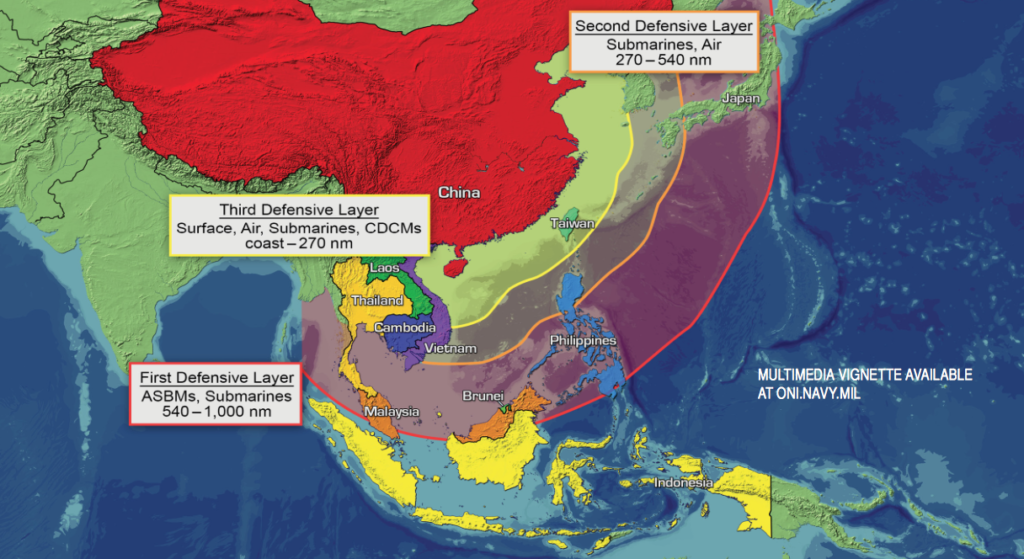
In the modern era, the technological edge has determined the supremacy of a nation at both the regional and global levels. The naval advancements in the 17th century not only connected the continents for trade and commerce but also led to the establishment of imperialism. Similarly, in the 20th century, nuclear supremacy determined the course of international affairs. In recent times, cyber, space technologies, and precision-based warfare equipment have become decisive factors that influence global events. Such capabilities include the Anti- Access Area Denial (A2/AD) systems, which are a combination of the land-based multi-domain capabilities that severely restrict the freedom of navigation of the adversary in the desired area.
As per Krepinevich, Andrew, Barry Watts, and Robert Work: “Anti-access –of enemy military movement into an area of operations – utilizes attack aircraft, warships, and specialized ballistic and cruise missiles designed to strike key targets. Area denial – denial of enemy freedom of action in areas under friendly control – employs more defensive means such as air and sea defense systems.” Earlier, these systems were exclusive to the US and its allies and partners, but in the past few years, both Russia and China have acquired such competence. Russia has deployed A2/AD systems in the Baltic Sea while China is prominently installing them across areas such as the South China Sea, the East China Sea, and Taiwan.
Today, the Indo-Pacific is the ‘grand stage’ where the global supremacy of the US is challenged by China’s economic and military rise can be distinctly observed. Any assertive action by China directly affects the US and its allies and partner in the region. In such a scenario, the deployment of A2/AD capabilities in the South China Sea and across Taiwan looms over the interests of the stakeholders. The development of long-range anti-ship ballistic missiles (ASBMs) and anti-ship cruise missiles (ASCMs) by the People’s Liberation Army threaten to deter many US operations in the Pacific Ocean (e.g., Okinawa, Guam, etc.). Japan has also shown its concerns regarding the Chinese assertiveness in the disputed Senkaku/Diayou islands in the East China Sea. According to a Japanese newspaper, in 2018, Chinese jets and naval vessels have passed over the Miyako Strait between Miyakojima (which is within 200kms range of the Senkaku Islands) and the main Okinawa island on several occasions.
Similar attempts have been made with regard to the claimants of the South China Sea disputed islands. The A2/AD capabilities, thus, have become prominent means for China to develop the “first and second island chains” in the Pacific Ocean.
These developments compel the US and its allies to take some defensive measures. For instance, the US installed the Terminal High Altitude Area Defence (THAAD) system in Guam in 2013 and South Korea in 2016 (even if the Chinese concerns have not overtly been expressed behind these moves). According to the defense experts, the deterrence by “raising the cost of aggression” can be an effective one in which the regional bases can be used by the ally countries to deploy “a mix of anti-ship, anti-aircraft, and surface-to-surface fires when they feel sufficiently threatened to employ force in their own defense” while they receive support and reinforcement from the United States.
Although there are different layers to the US-China rivalry in the Indo-Pacific region, the Anti-Access Area Denial system has become an influential factor in this phenomenon. The US and its allies are making efforts to avert or tackle any situation of aggression, but these capabilities have made China’s actions bold and self-assertive in the disputed areas more than ever. Furthermore, this does not limit itself to the China Seas and the Pacific Ocean. Since China has shown an increasing interest in the Indian Ocean region in the past few years, the growing presence of the Chinese fleet in the Indian Ocean concerns India and other littoral nations. Although the deployment of A2/AD capabilities across the Indian Ocean Rim seems too far-fetched, it is important for these countries to have some mechanisms to avoid any such advancements in the future. Meanwhile, the A2/AD factor will keep affecting the developments in one major part of the Indo-Pacific region and also the tug-of-war over freedom of navigation and the regional supremacy between the US and China.
*** The author is a PhD scholar at the Centre for Canadian, US & Latin American Studies, School of International Studies, Jawaharlal Nehru University ***
![]()

